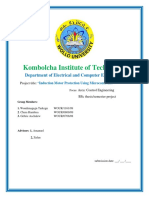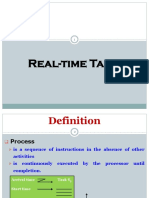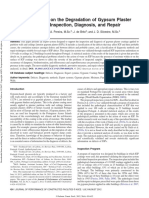An Improved Method For Protection of Three Phase Induction Motor Using Arduino
An Improved Method For Protection of Three Phase Induction Motor Using Arduino
Uploaded by
wondi BETCopyright:
Available Formats
An Improved Method For Protection of Three Phase Induction Motor Using Arduino
An Improved Method For Protection of Three Phase Induction Motor Using Arduino
Uploaded by
wondi BETOriginal Title
Copyright
Available Formats
Share this document
Did you find this document useful?
Is this content inappropriate?
Copyright:
Available Formats
An Improved Method For Protection of Three Phase Induction Motor Using Arduino
An Improved Method For Protection of Three Phase Induction Motor Using Arduino
Uploaded by
wondi BETCopyright:
Available Formats
International Conference on Communication and Information Processing
(ICCIP-2019)
Available on: Elsevier-SSRN
An Improved Method for Protection of Three Phase Induction
Motor Using Arduino
1
Rahul Dandale, 2Amol Chavan,3Vaibhav Falke, 4Dr .S .N. Patil
Student, Department of Electrical Engineering, University of Pune, JSPM’s BSIOTR, Wagholi, Pune,
1-3
Maharashtra, India;
Professor, Department of Electrical Engineering, University of Pune, JSPM’s BSIOTR, Wagholi, Pune,
4
Maharashtra, India.
Abstract: Recently observed that the conventional method used for protection for three phase induction
motor is taking time to operate and the cost of the system is high. So to overcome this, there is need of a
protection system which can operate in less time and has low cost. The mission is to create a system which has
slow cost and fast operation. This condition gave the basic idea about what was required in current Scenario.
The idea was to create a system which is cheap and will reduce the operation time. The system has the ability
and the economic value to for fulfilling the protection of three phase induction motor. This system is cost
effective and easy to maintain. This paper addresses to make a cheap and reliable protection system for three
phase induction motor. The protection system should protect the motor from voltage unbalancing, single
phasing, under voltage, over voltage and thermal protection. To improve the technique to run the motor below
single phasing. Taking the cost factor into consideration the design has been proposed using Arduino, relays,
small CTs and PTs. However the sensitivity of the protection scheme has been not compromised.
Keywords - Induction Motor Protection; Overvoltage; Under Voltage; Single Phasing; Overcurrent.
© 2019 – Authors.
I. INTRODUCTION
In this paper we develop an improved method for protection of three phase induction motor using
arduino for industries. Our main target is to protect three phase induction motor from various fault with using
one circuit in minimum time and at low cost by considering different factors such as ease of operation, time
of operation, cost of equipment. This is very cheap in cost but mainly used for protection of three phase
induction motor. So therefore we design a circuit which can protect motor from various faults. This
protection method protects motor from various faults such as over voltage, under voltage, overcurrent, single
phasing, thermal protection. This protection system requires minimum time for operation as it can work very
instantly. It will detect the fault and stop the motor. As the induction motor is main part of industry it is
important to provide a better protection system.
There is a need of better protection system for three phase induction motor as the conventional
system requires more time to operate. The system designed by us is better than conventional system as it can
operate in less time .As these system can detect the fault in less time and operate quickly due to which the
fault in motor does not extend. As the fault occurs in induction motor the system detect the fault and stops
the motor and display the fault on the screen. Due to this feature it is easy to rectify the fault as this is less
time consumption process. Due to the fast operation the fault can’t damage the motor.
II. LITERATURE REVIEW
Single phasing of three phase induction motor. William H. Kersting.
From this paper we had surveyed about the single phasing of the motor. How the single phasing occurs how
it can be prevented, so we developed a circuit which can detect the single phasing and can protect the motor
as the motor can run on a single phasing but it can damage the motor .so the circuit is developed which can
Electronic copy available at: https://ssrn.com/abstract=3418168
2 Dandale et.al./ICCIP 2019
detect single phasing.
Single Phasing, Phase Reversal, Overvoltage, Under Voltage And Overheating Protection Of Three Phase
Induction Motor. Devesh Kumar,Piyush KumarVerma.
From this paper we understand how the single phasing, under voltage, overheating occurs and how to protect
induction motor from this fault .So as per information the proposed work was to develop a system which can
detect this fault and provides protection to motor in a less time.
III. THE PROPOSED SYSTEM
A. WORKING :-
The data collected from voltage sensing and current sensing circuits are transferred to the arduino. The
arduino has inbuilt analog to digital (ADC) converter. Hence, external ADC unit is not needed.
Arduino A/D converter (ADC) is competent of processing input, which is less than 5V signal. Hence
sensors are to be selected according to the values.
The comparison are made with the practical value and the value which are entered in the program by
which the arduino can operate. When an abnormal condition occurs the motor is stopped by the control
signals .The motor parameters such as full load voltage, full load current are to be entered in protective
relaying program so as to automatically calculate and protect the motor.
The arduino based motor protection system is combination of control, monitoring and protection of
induction motor from the different faults in a single circuit assembly. The system provides protection
from single phasing, under voltage, over voltage, over current, overheating .The controller of the
system is implemented by arduino. LCD display is used to display the fault occurred in the system.
The system is very sensitive and fast it can detect the fault while running or before starting of motor.
The system is developed and tested on three phase induction motor with rated current of 3A and the
results of the testing are satisfying. When the values of under voltage and over voltage get exceeds
from the programmed values then controller generates trip signal which switch off the motor and
display the fault which are occurred in induction motor by which it is easy to detect the fault and
correct it in less time.
Hence induction motor is protected from overvoltage, under voltage, over current. The other faults are
also monitored and protected which are occurred in induction motor. The circuit diagrams are provided
below
Fig no. 4.1a Model Half wave rectifier Fig no. 4.1b Half Wave Circuit
diagram
B. HALF WAVE RECTIFIER:
A simple Half Wave Rectifier is nothing additional than a single pn junction diode connected in series to
the load resistor. As you know a diode is to electric current ,it allows electric current to flow in only one
direction. This property of the diode is very useful in creating simple rectifiers which are used to convert
AC TO DC.
Electronic copy available at: https://ssrn.com/abstract=3418168
An Improved Method for Protection…. 3
Fig no. 4.2a Model Relay circuit Fig no. 4.2b Relay Circuit
diagram
C. RELAY CIRCUIT:
It is an electro-magnetic relay with a wire coil, surrounded by an iron core. A path of terribly low reluctance
for the magnetic flux is provided for the movable coil and additionally the switch purpose contacts. The
movable coil is connected to the yoke that is automatically connected to the switch purpose contacts. These
components area unit safely command with the assistance of a spring. The spring is used stop produce an air
gap in the circuit when the relay becomes de-energized.
Fig no : 4.3a Model LCD Display Fig no : 4.3bLCD Display Circuit
diagram
D. LCD DISPLAY :
LCD (Liquid Crystal Display) screen is associate degree electronic show module and notice a
good vary of applications. A 16x2 LCD display is incredibly basic module and is incredibly
unremarkably employed in varied devices and circuits. These modules are preferred over seven
segments and other multi segment LEDs. The reasons being: LCDs are economical; easily
programmable; have no limitation of displaying special & even custom characters (unlike in
seven segments) animation and so on.
A 16x2 LCD means it can display 16 characters per line and there are 2 such lines. In this LCD
each character is displayed in 5x7 pixel matrix. This LCD has two registers, namely, Command
and Data.
Electronic copy available at: https://ssrn.com/abstract=3418168
4 Dandale et.al./ICCIP 2019
Fig no. 4.4a Model Current Sensor Fig no. 4.4b Current Sensor
Circuit diagram
E. Current sensor:
ACS712 current detector operates from 5V and outputs analog voltage proportional to current measured on
the sensing terminals. You can simple use a arduino ADC to read the values. Sensing terminal can even
measure current for loads operating at high voltages like 230V AC mains while output sensed voltage is
isolated from measuring part.
Features:
100 mV/A output sensitivity
5.0 V, single supply operation
Output voltage proportional
to AC or DC currents Ratio
metric output from supply
voltage
5 microsecond output rise time in response to step input current
V. MODEL CIRCUIT:
Electronic copy available at: https://ssrn.com/abstract=3418168
An Improved Method for Protection…. 5
VI. BLOCK DIAGRAM:
INP
UT
Circuit
breaker
Transfor LCD Rectifier
mer Display circuit
1
Current
senso
r1
Transfor
mer
2
Relay
Current ARDUINO
sensor
2
Transfor
mer
3
Frequency Conta
Current Circuit ctor
sen
sor
3 III.IM
I
Fig no 6.1 Block diagram of Protection Technique for 3 phase IM.
VII. ADVANTAGES OF ARDUINO BASED PROTECTION SYSTEM :
This system is fastest method as it takes less time to operate due to which the the fault did not
increase in motor and the damage to the motor is less.
The operation time of the system is less due to which it can detect fault in less time and stops the
motor
The operation of the sytem is safe as it can be handle very easily
Simple circuit as it can be understandable to all.
Drawbacks of the Present Protection System:
1. The speed of the operation of the convention system is more as it can damage the induction motor.
2. The system required different circuits for different faults protection due to which the the cost of the
protection system is increased .
3. The conventional system has complicated circuit due to it becomes difficult to understsand .
4. Due to the different circuits the system becomes bulkier.
VIII. RESULT AND DISCUSSION :
R-Ph:272.4 volt
Y-Ph:272.4 volt
Over voltage tripping
B-Ph:272.4 volt
R-Ph: 197volt
Under voltage tripping Y-Ph: 197 volt
B-Ph: 197 volt
Over current 3.1 A
Single phasing R-Ph or Y-Ph or B-Ph Are Absent
Tripping Time 2.3 sec
Electronic copy available at: https://ssrn.com/abstract=3418168
6 Dandale et.al./ICCIP 2019
This protection System is improved method because the convention system used in industries are complicated
and the conventional system are bulkier because different circuits are used for different protection. But our
system is having a single circuit from which the different fault can detected and the protection is applied to
motor as the motor supply is cut off after the fault detection and it also display the fault on the screen due to
which becomes easy to rectify the fault. As the conventional system requires more time to operate due to
which the fault can increase and result in severe damage of motor .But the system designed by us operate in
less time due to which the fault did not increase. In our protection system single circuit can detect different
faults and protect the motor due to which it requires less space. In this system we had used electronic circuit
which can operate quickly. Hence it is the improved method for protection of three phase induction motor.
IX. CONCLUSION:
This protection system is an improved method because it is very less time operating and low cost protective
device as compared to other protective devices. The system is tested in the laboratory for many times on
three phase induction motor under faulty condition and it gives desirable results. The system is reliable and
rugged. This is for the protection of motor for under voltage, over voltage, unbalance voltage, over current
and single phasing.
X. REFERENCES :
[1] Vikram Singh, Abhishek Gupta, Ankit Gupta, Aniruddha Garg, Ankush Khandelwal, Akshay Gupta
“Induction Motor Protection System”, Imperial Journal Of Interdisciplinary Research (IJIR) Vol-3,
Issue-3, 2017
[2] Devesh Kumar, Piyush Kumar Verma, Brijesh Kumar Singh, Ravindra Singh, Vishal Singh “Single
Phasing, Phase Reversal, Overvoltage, Under Voltage And Overheating Protection Of Three Phase
Induction Motor”, International Journal Of Scientific Research And Management Studies (IJSRMS)
ISSN: 2349-3771 Volume 1 Issue 1,
[3] Harsha Jain, Surbhi Shrivastava “Modern Method For Protection Of Induction Motor Using
Microcontroller And Wi-Fi Technology”,International Journal Of Innovative Research In Computer
And Communication Engineering (An ISO 3297: 2007 Certified Organization) Vol. 4, Issue 6, June
2016
[4] Horowitz SH, Phadke AG (2008) Power System Relaying. In: Horowitz SH, Phadke AG “Rotating
Machinery Protection”, John Wiley and Sons, England, Pp.159-178.
[5] Chattopadhyay S., Chattopadhyaya A. and Sengupta S., "Analysis of stator current of induction motor
used in transport system at single phasing by measuring phase angle, symmetrical components,
skewness, kurtosis and harmonic distortion in park plane," Electrical Systems in Transportation, IET ,
Vol. 4, no. 1, pp. 1-8, March 2014
[6] Ransom D.L. and Hamilton R., "Extending Motor Life With Updated Thermal Model Overload
Protection," IEEE Transactions on Industry Application, vol. 49, no. 6, pp. 2471 2477, Nov.-Dec. 2013.
[7] Kersting W.H., "Causes and effects of single-phasing induction motors," IEEE Transactions on
Industry Applications, Vol. 41, no. 6, pp. 1499-1505, Dec. 2005
Electronic copy available at: https://ssrn.com/abstract=3418168
You might also like
- The Subtle Art of Not Giving a F*ck: A Counterintuitive Approach to Living a Good LifeFrom EverandThe Subtle Art of Not Giving a F*ck: A Counterintuitive Approach to Living a Good LifeRating: 4 out of 5 stars4/5 (6025)
- The Gifts of Imperfection: Let Go of Who You Think You're Supposed to Be and Embrace Who You AreFrom EverandThe Gifts of Imperfection: Let Go of Who You Think You're Supposed to Be and Embrace Who You AreRating: 4 out of 5 stars4/5 (1133)
- Never Split the Difference: Negotiating As If Your Life Depended On ItFrom EverandNever Split the Difference: Negotiating As If Your Life Depended On ItRating: 4.5 out of 5 stars4.5/5 (911)
- Grit: The Power of Passion and PerseveranceFrom EverandGrit: The Power of Passion and PerseveranceRating: 4 out of 5 stars4/5 (628)
- Hidden Figures: The American Dream and the Untold Story of the Black Women Mathematicians Who Helped Win the Space RaceFrom EverandHidden Figures: The American Dream and the Untold Story of the Black Women Mathematicians Who Helped Win the Space RaceRating: 4 out of 5 stars4/5 (938)
- Shoe Dog: A Memoir by the Creator of NikeFrom EverandShoe Dog: A Memoir by the Creator of NikeRating: 4.5 out of 5 stars4.5/5 (548)
- The Hard Thing About Hard Things: Building a Business When There Are No Easy AnswersFrom EverandThe Hard Thing About Hard Things: Building a Business When There Are No Easy AnswersRating: 4.5 out of 5 stars4.5/5 (359)
- Her Body and Other Parties: StoriesFrom EverandHer Body and Other Parties: StoriesRating: 4 out of 5 stars4/5 (831)
- Elon Musk: Tesla, SpaceX, and the Quest for a Fantastic FutureFrom EverandElon Musk: Tesla, SpaceX, and the Quest for a Fantastic FutureRating: 4.5 out of 5 stars4.5/5 (481)
- The Emperor of All Maladies: A Biography of CancerFrom EverandThe Emperor of All Maladies: A Biography of CancerRating: 4.5 out of 5 stars4.5/5 (275)
- The Yellow House: A Memoir (2019 National Book Award Winner)From EverandThe Yellow House: A Memoir (2019 National Book Award Winner)Rating: 4 out of 5 stars4/5 (99)
- The Little Book of Hygge: Danish Secrets to Happy LivingFrom EverandThe Little Book of Hygge: Danish Secrets to Happy LivingRating: 3.5 out of 5 stars3.5/5 (434)
- Devil in the Grove: Thurgood Marshall, the Groveland Boys, and the Dawn of a New AmericaFrom EverandDevil in the Grove: Thurgood Marshall, the Groveland Boys, and the Dawn of a New AmericaRating: 4.5 out of 5 stars4.5/5 (273)
- The World Is Flat 3.0: A Brief History of the Twenty-first CenturyFrom EverandThe World Is Flat 3.0: A Brief History of the Twenty-first CenturyRating: 3.5 out of 5 stars3.5/5 (2283)
- The Sympathizer: A Novel (Pulitzer Prize for Fiction)From EverandThe Sympathizer: A Novel (Pulitzer Prize for Fiction)Rating: 4.5 out of 5 stars4.5/5 (125)
- A Heartbreaking Work Of Staggering Genius: A Memoir Based on a True StoryFrom EverandA Heartbreaking Work Of Staggering Genius: A Memoir Based on a True StoryRating: 3.5 out of 5 stars3.5/5 (233)
- Team of Rivals: The Political Genius of Abraham LincolnFrom EverandTeam of Rivals: The Political Genius of Abraham LincolnRating: 4.5 out of 5 stars4.5/5 (235)
- SD Pro Scanner - Service ManualDocument71 pagesSD Pro Scanner - Service ManualMike SettleNo ratings yet
- Class 12 Physics Investigatory ProjectDocument12 pagesClass 12 Physics Investigatory Projectdjjeena619No ratings yet
- On Fire: The (Burning) Case for a Green New DealFrom EverandOn Fire: The (Burning) Case for a Green New DealRating: 4 out of 5 stars4/5 (75)
- Project Proposal 1Document14 pagesProject Proposal 1wondi BETNo ratings yet
- The Unwinding: An Inner History of the New AmericaFrom EverandThe Unwinding: An Inner History of the New AmericaRating: 4 out of 5 stars4/5 (45)
- CiTRANS 610A Packet Transfer Platform User ManualDocument286 pagesCiTRANS 610A Packet Transfer Platform User ManualShailendra Rawat50% (2)
- "Final Year Ece Projects in Chennai, Bangalore, Vijayawada, Kakinada." GoodDocument18 pages"Final Year Ece Projects in Chennai, Bangalore, Vijayawada, Kakinada." Goodwondi BETNo ratings yet
- Thermal Printer: Programmer's Guide (Edition 2018)Document154 pagesThermal Printer: Programmer's Guide (Edition 2018)wondi BETNo ratings yet
- Design of Amharic Teleprinter (Teletype) : by Raswork, The Imperial Board EthiopiaDocument7 pagesDesign of Amharic Teleprinter (Teletype) : by Raswork, The Imperial Board Ethiopiawondi BETNo ratings yet
- Detection of Fault of Three Phase Induction Motor Using Arduino Uno R2 MicrocontrollerDocument3 pagesDetection of Fault of Three Phase Induction Motor Using Arduino Uno R2 Microcontrollerwondi BETNo ratings yet
- Protection of Three Phase Induction Motor Using MicrocontrollerDocument3 pagesProtection of Three Phase Induction Motor Using Microcontrollerwondi BETNo ratings yet
- Apply For Ethiopian Passport OnlineDocument1 pageApply For Ethiopian Passport Onlinewondi BET100% (1)
- Induction Motor: by Ashvani Shukla Manager (C&I) BGR EnergyDocument15 pagesInduction Motor: by Ashvani Shukla Manager (C&I) BGR Energywondi BETNo ratings yet
- I C H T S: 2 Umidity AND Emperature EnsorDocument36 pagesI C H T S: 2 Umidity AND Emperature Ensorwondi BETNo ratings yet
- An Improved Method For Protection of Induction Motor Using MicrocontrollerDocument64 pagesAn Improved Method For Protection of Induction Motor Using Microcontrollerwondi BETNo ratings yet
- PLCC2835 0.5W EdisonDocument17 pagesPLCC2835 0.5W Edisonwondi BETNo ratings yet
- 1.2 Basic Digital Control System: Input To A Controlled SystemDocument22 pages1.2 Basic Digital Control System: Input To A Controlled Systemwondi BETNo ratings yet
- Proposal Format:: Project Title: "Document4 pagesProposal Format:: Project Title: "wondi BETNo ratings yet
- For FinalExamDocument65 pagesFor FinalExamwondi BETNo ratings yet
- Control and Computer Chapter1 2013Document45 pagesControl and Computer Chapter1 2013wondi BETNo ratings yet
- Project Proposal 11Document15 pagesProject Proposal 11wondi BETNo ratings yet
- Introduction To Neural Networks - Chapter1Document43 pagesIntroduction To Neural Networks - Chapter1wondi BETNo ratings yet
- Simulation Analysis of Full Protected inDocument53 pagesSimulation Analysis of Full Protected inwondi BETNo ratings yet
- NCSOSET4Document5 pagesNCSOSET4wondi BETNo ratings yet
- Induction Motor Protection Using Micro Controller: NtroductionDocument5 pagesInduction Motor Protection Using Micro Controller: Ntroductionwondi BETNo ratings yet
- Unit 3 WavesDocument19 pagesUnit 3 Waveskhansuma099No ratings yet
- Carter Steel Guitar Owners ManualDocument17 pagesCarter Steel Guitar Owners ManualGuitar RoomNo ratings yet
- Pertumbuhan Dan Hasil Cabai Rawit Capsicum FrutescDocument13 pagesPertumbuhan Dan Hasil Cabai Rawit Capsicum FrutescFajar Kurniadi WiranataNo ratings yet
- Cat SIS Jan 2017 New Information in SISDocument26 pagesCat SIS Jan 2017 New Information in SISisaac989100% (1)
- Pre Medical Nurture Test Series Detailed SyllabusDocument8 pagesPre Medical Nurture Test Series Detailed SyllabusLishaNo ratings yet
- 0 - Course IntroductionDocument8 pages0 - Course IntroductionMohammad AliNo ratings yet
- 1 04 Student WorksheetDocument2 pages1 04 Student WorksheetKatieNo ratings yet
- Effect of Water On The Degradation of Gypsum PlasterDocument9 pagesEffect of Water On The Degradation of Gypsum PlasterTaciane FrancescattoNo ratings yet
- Ex5 Eg Om PDFDocument110 pagesEx5 Eg Om PDFSharkawi ArusmanNo ratings yet
- Pulmonary EdemaDocument10 pagesPulmonary EdemaNader Smadi100% (6)
- A_Simplified_Method_for_Analysis_of_Laterally_LoadDocument10 pagesA_Simplified_Method_for_Analysis_of_Laterally_Loadel2a32a3No ratings yet
- Final Drug StudyDocument9 pagesFinal Drug StudyCherry Lou Correos Tejada100% (2)
- Hoffmann SignDocument5 pagesHoffmann SignClaudio Andrés Olmos de AguileraNo ratings yet
- HVA PlanDocument9 pagesHVA PlanPuskesmas kesesi1No ratings yet
- 2021 Life Sciences Prep Exam Paper 2 FS MemoDocument10 pages2021 Life Sciences Prep Exam Paper 2 FS Memokwanellethunzi9No ratings yet
- Motor and Transformer Feeder Protection Using Siperotec RelayDocument20 pagesMotor and Transformer Feeder Protection Using Siperotec RelayAhsan Ul JawadNo ratings yet
- CB0191 - Ramsetreid - Precast - Solutions - AUS - Product - Guide - 2019 - Update (Reid Ferrules)Document70 pagesCB0191 - Ramsetreid - Precast - Solutions - AUS - Product - Guide - 2019 - Update (Reid Ferrules)Catherine Fatima Mae LeynoNo ratings yet
- 211in Model Uses TableDocument1 page211in Model Uses TableFIORELLA ANGELA MARTINEZ MORANo ratings yet
- Electric Boiler Design Calculations-ASME SEC.I, PART-PEB, EDITION 2019 PDFDocument48 pagesElectric Boiler Design Calculations-ASME SEC.I, PART-PEB, EDITION 2019 PDFSuresh Damu Bhad100% (1)
- Oscillator OptionsDocument9 pagesOscillator Optionsadsad adaNo ratings yet
- PDS Lubrizol-6950pDocument4 pagesPDS Lubrizol-6950pBurcu Taşçı100% (1)
- Brassington - Lecture 6 - Branding & ProductDocument55 pagesBrassington - Lecture 6 - Branding & Productsunny_medipalliNo ratings yet
- Tractor Factor (Fall 2021, The Daily News)Document5 pagesTractor Factor (Fall 2021, The Daily News)Watertown Daily TimesNo ratings yet
- Consumption of Alcoholic Beverages 1. Exposure DataDocument130 pagesConsumption of Alcoholic Beverages 1. Exposure Databasge7414No ratings yet
- En Operator's Manual 860i Stage V 2020 - (A432324 2020 3) WebDocument142 pagesEn Operator's Manual 860i Stage V 2020 - (A432324 2020 3) WebcraigNo ratings yet
- 2 e 4 15h00 - American Think 1Document109 pages2 e 4 15h00 - American Think 1Fernando Mafalda FreireNo ratings yet

























































































